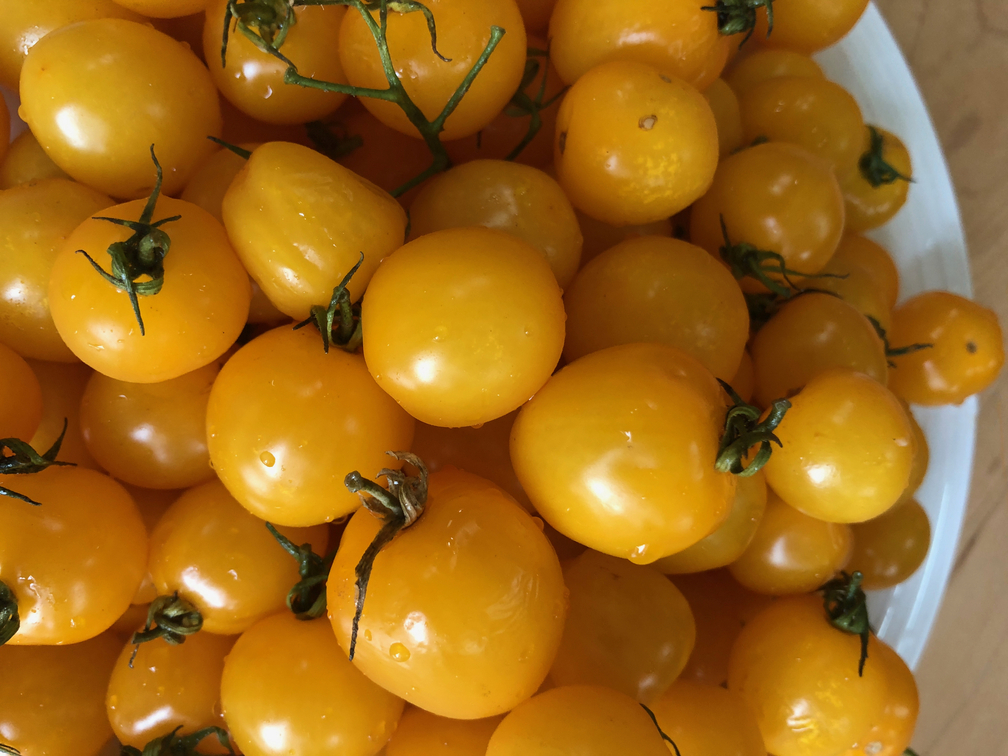Of all the vegetables I grow, tomatoes are my favorite. Hands down, it’s tomatoes. A few years ago, I grew 18 different kinds of tomatoes in my garden beds, just to see how they all compared. It was glorious.
I’m often asked which tomatoes I recommend. That is an impossible question to answer. Everyone’s growing conditions are different, not just in different states or different counties or neighborhoods, but even from one backyard to the next, the growing conditions can be surprisingly different. And those differences determine whether a particular kind of tomato will thrive and produce, or simply survive.

Two days’ harvest from my garden
There are thousands of varieties of tomatoes available as seed and certainly hundreds now sold in nurseries as seedlings. So rather than urge you to grow my favorite (which from that summer of 18 tomatoes, turns out to be a Japanese hybrid called Apple Yellow, which is an All-American Selections winner – thank you Diane Blazek for the seeds!), here’s a rundown of the types of tomatoes typically sold by seed companies and as seedlings.
Slicing (Beefsteak) tomatoes produce very large, often crenulated fruits. I tend to think of slicing tomatoes as those so large that a single slice covers an entire hamburger.
Plum (aka paste, Roma, processing, saladette) varieties are oval or cylindrical with meaty walls and not many seeds. These tomatoes are bred to be less “juicy” than other types of tomatoes. They are perfect for cooking, canning, juicing, or using in salsas and gazpachos.
 Cherry tomatoes range from large marble size to as tiny as a pea. Those tiny cherry varieties are sometimes called “currant” tomatoes. While red cherry tomatoes dominate, one of the most popular is a yellow variety called ‘Sun Gold.’ There are also black cherry tomatoes. Cherry tomatoes tend to grow on large, indeterminate (vining) plants that need sturdy support, lest they form big, convoluted mounds of branches and leaves that sprawl on the ground.
Cherry tomatoes range from large marble size to as tiny as a pea. Those tiny cherry varieties are sometimes called “currant” tomatoes. While red cherry tomatoes dominate, one of the most popular is a yellow variety called ‘Sun Gold.’ There are also black cherry tomatoes. Cherry tomatoes tend to grow on large, indeterminate (vining) plants that need sturdy support, lest they form big, convoluted mounds of branches and leaves that sprawl on the ground.
Grape tomatoes are on the scale of cherry tomatoes but with firmer flesh, though not as firm and meaty as plum tomatoes. Grape tomatoes are slightly sweeter and a bit juicier than plums, too. These perfect “pop in your mouth” tomatoes are typically red but sometimes yellow.
If you choose to start tomatoes from seed, plant them in containers indoors anytime between the first of March and the middle of June. They’ll be ready to transplant in six to eight weeks and you’ll be harvesting in about two months.
 Plant seeds in a high-quality seed starting mix. Don’t reuse or recycle old seed starting mix. Set the seeds atop damp seed starting mix and cover them just barely with the same damp mixture. Gently press down to make sure the seeds are in contact with the damp seed starting mix.
Plant seeds in a high-quality seed starting mix. Don’t reuse or recycle old seed starting mix. Set the seeds atop damp seed starting mix and cover them just barely with the same damp mixture. Gently press down to make sure the seeds are in contact with the damp seed starting mix.
Place the pot a brightly lit window where temperatures stay between 65 and 70 degrees — any cooler and the seeds won’t germinate. Any warmer and they grow too fast and leggy. I sit mine on a seedling heat mat to ensure just the right temperature.
Keep the soil damp. Fertilizer with a dilute liquid fertilizer after the second set of leaves appear.
Once the seedlings have several sets of leaves and the night air is reliably 50 degrees or warmer, plant your seedlings outside. There’s a special way to plant tomato seedlings. With all other seedlings, the seedling has to sit at the same level in the garden as it sat in the pot – no deeper and no higher. But tomatoes get planted deep. So, dig a shallow, diagonal “trench,” then bury the stem up to the first leaves. New roots will form along the buried portion of the stem, making for a strong and well-rooted tomato plant.
Before you plant though, make sure to have a strong support in place for your tomato plants. Forget those wimpy conical “tomato cages” nurseries all stock. Make your own from a piece of concrete reinforcing mesh and some zip ties or splurge on pre-made tomato towers.
 In a few months, you’ll have a bounty of harvest. These tropical plants need heat to ripen fruits but when temperatures get too hot, the flowers won’t pollinate. That’s why production often takes a break in the heat of summer.
In a few months, you’ll have a bounty of harvest. These tropical plants need heat to ripen fruits but when temperatures get too hot, the flowers won’t pollinate. That’s why production often takes a break in the heat of summer.
When all goes well, you’ll have an abundance of tomatoes. What will you do with all that harvest? Read my suggestions here.
Want to learn more about growing tomatoes and other kinds of plants? Sign up for my GardenWise Monthly garden subscription.





